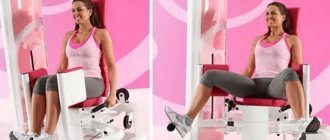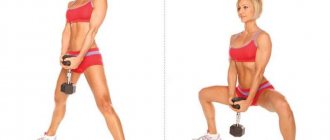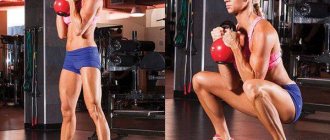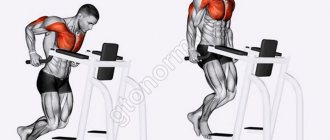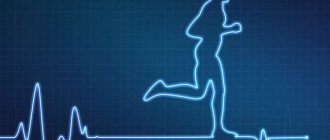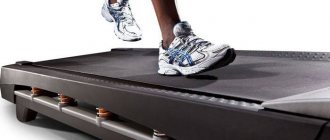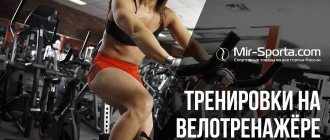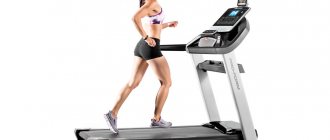Exercises and training program
The basic complex includes a short and long stroke. The exercises are performed in 3 sets, each with 10–20 repetitions.
Short stroke
Starting position (hereinafter referred to as I.P.): sitting, lower limbs bent at the knee joint, feet secured with belts. Arms extended forward, grip straight. Slowly push off with your feet, move back, and at the end point pull your arms to your chest. Smoothly in I.P.
Long stroke
IP: as with a short stroke, but the feet are fastened with straps so that the heels are slightly torn off the stop. The back is slightly rounded, the head is pulled forward, the arms are straightened, in a direct grip on the handles.
Push off with the front of the foot, moving backward, straightening the torso. At the same time, bend your elbows and pull the handle towards your collarbones. Smoothly in I.P.
The more you straighten your torso when performing the first phase of the exercise, the more your back and abdominal muscles are loaded.
It is recommended to tilt your torso 45 degrees.
Accented triceps training
IP: sit on the seat with your back forward, your legs are placed on the sides of the bench, resting on the floor, bent at the knees. With your arms bent at the elbow joints and behind your head, hold onto the handle. The arms are gradually straightened perpendicularly, giving a load to the triceps, then at the same pace they are returned to the starting position.
Targeted development of deltoid muscles
I.P.: standing in front of the simulator, legs spaced shoulder-width apart, back not rounded. The handle is held with palms down. Raise your arms until they form a parallel with the floor surface and lower them.
Training scheme
The content of the training program depends on the athlete’s preparation:
| Level | Training frequency per week (times) | How many approaches | Duration of the approach | Lesson duration (minutes) |
| Beginner (first 14 days) | 2–3 | 3 | 10 short and long strokes each | 15–20 |
| Average | 3 | 3 | 7 minutes | 30 |
| High | 4 | 5 | 10–12 minutes | 40–60 |
Take a 5-10 minute break between approaches. This time is intended for active rest, which involves stretching and light exercises to prevent the muscles from cooling down.
Errors in technology
Now you know how to properly exercise on the Rowing machine. But often during exercise, mistakes are made in which the wrong muscle groups are used that should be under stress. Many people do not perform arm pulls; they hunch over and pull the handle using the strength of their back muscles. This is not true. Your back needs to be open and your chest pointing forward.
Other mistakes are insufficient abdominal tension and shallow breathing. It is important that all muscles are always in a noticeable tone. You cannot hold your breath. You need to inhale and exhale as much air as possible so that your lungs expand.
The third mistake is raising your hands too high. no need to press the “paddle” to your throat. This way you are using more force than is actually necessary. Pull the handle toward your chest. Make sure that at the end of the approach your elbows are bent almost at a right angle. Forearms should be at chest level.
Beginning athletes often spread their knees to the sides. In this case, the inner thigh is not involved in the work. To avoid this mistake, move your knees as close together as possible when pushing off the platform. Lock this position and also adjust the straps - they should be located at the base of the thumbs.
Execution technique
In order for the classes to bring maximum benefit, you have to learn the technique of movements. Strengthening your back and improving your silhouette occurs in 3–4 months. The stroke consists of two phases:
- craving;
- return.
Traction
The lower limbs are straightened, the body is tilted back. The back and legs are mainly loaded. Arms are straightened, shoulders relaxed. At the end of the movement, the arms are bent and the shoulders are extended. The body is slightly tilted, the legs are straightened. The handle is pulled towards the abdominal muscles.
Return
Move forward, starting from the hip. The seat of the projectile moves towards the flywheel mechanism, and the trajectory of the upper limbs does not intersect with the trajectory of the lower ones.
Recommendations and common mistakes
Every time before training, do a warm-up to increase blood circulation and prepare the body for further stress.
The normal duration of rowing machine sessions is 50 minutes. During this time, the athlete manages to complete three sets of exercises.
Classes begin with 20 minutes, gradually extending them. The load regulator (if provided by the model) is set to the lowest level. The main goal when mastering the installation is to tone the body.
Intense and long-term training is contraindicated during this period. A sign that you can increase the load is the absence of muscle discomfort.
The most common mistakes that result in diseases of the musculoskeletal system:
- when performing movements, the load falls on the knees, which leads to the development of joint disease;
- keep your back bent;
- make sudden movements or suddenly stop the exercise.
Stop training if your health worsens in any way—weakness, dizziness, nausea. Despite the benefits of the rowing simulator, people with certain heart and vascular diseases and cerebrovascular disorders are not allowed to participate in training.
Postponed training until recovery in case of acute bacterial and viral respiratory tract infections, high body temperature, or general malaise. Before starting training, consultation with a doctor is necessary if you have chronic illnesses or are over 35 years old.
The benefits and harms of rowing machines
Exercising on a rowing machine is considered cardio exercise.
Rowing exercises strengthen:
- respiratory
- cardiovascular
- nervous system
Rowing is improved:
- muscle corset
- increase the body's endurance
- speed up metabolism
In one session lasting 30-40 minutes, an athlete spends about 800 Kcal - an excellent indicator in the fight against excess weight.
Modern electromagnetic simulators are equipped with special computer programs that clearly control the entire training process. Another advantage is the fact that rowing machines at a low pace are recommended even for pregnant women.
Thanks to exercises on a rowing machine, reliable prevention of diseases of the musculoskeletal system and spine is carried out, and also increases flexibility and mobility of joints.
Studies show that regular training on a simulator increases sexual activity in women and men.
If you are considering using a rowing machine, consult your doctor first. Sometimes exercise is harmful to the body.
Rowing is contraindicated for people with the following diseases:
- Hypertension
- Thyroid diseases
- Cardiovascular diseases
- Infectious diseases (ARVI, influenza)
- Some diseases of the spine
What is a trainer
The apparatus imitates rowing on the water, repeating the movements of oars as accurately as possible. Let's look at it in more detail.
Main functions of the device:
- develops and strengthens muscles, keeps them in good shape;
- effective for weight loss (burns fat deposits);
- stretches and strengthens tendons and ligaments;
- straightens posture, corrects coordination of movements.
Important! In case of spinal hernia or osteochondrosis, the load on the back during exercise on the exercise machine should be as gentle as possible. It is advisable to draw up a training program with a professional trainer. Capabilities and features of the sports instrument:
Capabilities and features of a sports instrument:
- brings exercises as close as possible to real rowing on water (some models, thanks to the built-in fan, imitate the blowing of wind);
- you can adjust the intensity of the workout (equipped with a timer);
- it is possible to monitor the pulse and other indicators of the body;
- easy to fold;
- easy to maintain;
- easy to move using special rollers;
- provided with stable supports.
The design and principle of operation of existing models may differ slightly, but the basis of all designs is the same:
- flywheel - provides tension and stretching of the cable;
- seat;
- handles (oars).
Currently there are 3 types of devices:
- Mechanical ones are compact, inexpensive, suitable for beginners, since they can easily adjust the degree of load.
- Magnetic - silent, equipped with a computer that allows you to select the program and intensity.
- Aerodynamic - more suitable for gyms, take up a lot of space, and are noisy. The package includes a fan that creates additional resistance to air flow.
Find out what is more effective for losing weight: a treadmill or an exercise bike.
Benefits and indications
Thanks to the large amplitude of movement, the effectiveness of working out almost all muscles is ensured: shoulders, back and abdomen, legs and arms, chest area. Indications for use and benefits of training on a rowing machine:
- improved blood circulation;
- improvement of lung function - tissues are saturated with oxygen;
- strengthening the heart muscle and blood vessels;
- normalization of the central nervous system;
- maintaining muscle tissue in tone, muscle relief;
- help in the fight against diseases and deformities of the spine.
Harm and contraindications
In addition to the benefits, sports activities on a rowing machine have a number of contraindications:
- brain disorders;
- serious heart disease;
- shoulder joint problems;
- displacement of intervertebral discs.
Important! If you have existing health problems, you should consult your doctor before starting exercise. The disadvantages of the simulator also include its dimensions: some designs take up a lot of space and can also make noise
The disadvantages of the simulator also include its dimensions: some designs take up a lot of space and can also make noise.
Rowing technique on a rowing machine
1. Capture. The starting point of movement on a rowing machine is similar to a squat. The back is straight, the legs are tense and clenched, the arms are extended, the fingers hold the handle tightly. The body is slightly tilted, the chest is open and looking forward, the abs are tense, the latissimus dorsi muscles are relaxed.
2. Push. The movement begins with pushing off with the strength of the leg muscles and activating the shoulder girdle. Next, the biceps is activated, pulling the handle of the exercise machine towards the stomach. The back muscles open, pushing the chest forward. At the same time, the muscles of the thighs and buttocks straighten the leg at the knee.
3. Traction. The abdominal muscles are involved in the work, stabilizing the body position; buttocks and thigh muscles are tense. The arms, using the force of the biceps, pull the handle even closer to the belt - at the same time, the chest is pushed even further forward to increase the range of movement.
4. Recovery. The handle, held by the force of the triceps, moves forward. Next, bending slightly, the body moves forward (the abdominal muscles are tense and the back is straight). Only after this do the legs bend at the knees. The movement ends in the starting grip position.
Kinds
The principle of operation is described by the name of the simulator. It simulates rowing a boat. During training, more than 80% of the muscles are used. There are two types of simulator: magnetic and mechanical.
Mechanical
Suitable for those who are just starting out. Mechanical simulators are cheaper than magnetic ones. However, they have less functionality compared to more expensive shells.
Depending on the type of load, mechanics can be divided into aerodynamic and hydraulic. The aero rowing machine has fans. It creates air resistance. Hydraulic - spring projectiles. The operating principle is based on the elasticity of mechanical parts.
Magnetic
The projectile is almost silent, its movements are smooth. It is more durable compared to mechanical ones. Training on this machine is more comfortable due to its functionality. The magnetic system allows you to set different difficulty levels. There are also models in which you can separately regulate the load on your hands.
This type of projectile is more expensive than mechanical ones. They are more impressive in size. Therefore, not everyone can use them at home. They are equipped with an electronic system that shows the load, pulse, and counts calories burned. The magnetic system creates good resistance to the exerciser. It is easily adjustable, even without stopping the training process.
What is a rowing machine?
Exercises on a rowing device replicate the movements of oars on a boat. The design consists of a frame, a moving seat, one or two levers, and a foot rest. The scheme of work is simple: during training, the athlete takes the position of a rower on a seat, pulling one or two levers with a cable. Thus, it works against resistance and imitates the work of oars.
Some models of the simulator are equipped with a control panel and special electronic motion sensors. The speed and strength of the load can be adjusted depending on the type of sports equipment.
There are three types of rowing machines:
- Mechanical. The principle of operation of the device is the resistance of hydraulic cylinders, which make noise and move unevenly, simulating being in a boat. Thanks to the simple mechanism, you can assemble the exercise machine even at home. The resistance is also based on hydraulic or aerodynamic systems.
- Magnetic. Unlike mechanical sports equipment, the magnetic design is more functional. The device is equipped with magnets, an electronic display with a set of functions and a flywheel. Resistance is achieved by the movement of magnets relative to each other. Exercising on such a simulator is convenient due to its noiselessness, smooth movement, pulse and calorie control.
- Electromagnetic. The operation of this type of rowing machine is carried out due to electromagnetic resistance. The load level is controlled by the supply of current, which can be increased or decreased on the control panel.
Frame assembly
Saw off 6 short pieces of 30 cm length from a wooden beam. Then cut both ends of each beam at an angle of 45 degrees. Now you need to saw off from the beam 6 bars 10 cm long each, 2 bars 18 cm long, 3 bars 40 cm long, 2 bars 42 cm long, 2 bars 19 cm long and 2 more bars 73 cm long. Finally, make 2 long bars of 170 cm each. Next, we cut out square recesses at one end of the bars 170 and 40 cm long. The depth of the recess should be half the section of the beam, that is, 2 cm, and the length and width should be 4 cm each Glue the 170 cm and 40 cm bars with wood glue, folding them at right angles in the grooves. Fasten the structure with two 30 cm long bars (with the corners already cut off), screwing them with two screws on the inside of the resulting right angle. Measure 3 cm from the edge at the opposite end of the 170 cm bar and drill a hole with a 15 mm drill. Drill a 1cm deep hole directly over this hole using a 32mm drill bit. Take the two resulting rectangular pieces and fasten them together with a 10cm long piece of wood, starting at the right angled edges. Secure the structure with clamps and let the glue dry. After this, add another 10 cm block at a distance of 25 cm from the edge, and another 83 cm from the edge. Take the last remaining 40 cm block. Measure 11 cm from both edges and put marks. We draw two squares 4 by 4 cm, the center of which will be the marks made. Along the drawn lines, cut a square recess 2 cm deep. Screw the 42 cm bars to the 73 cm bars, then drill a through hole in both with a 12 mm drill at a height of 20 cm. Now measure 120 cm and at this point screw the long beams of the not yet completed frame on top 42 cm bars. Next you need to screw the 18 cm bar on top of the long long ones - right between the 73 cm bars. Take another 18 cm bar and screw it between the upper edges of the 73 cm bars. Almost ready. It remains to screw 2 19 cm bars in a vertical position between the 18 cm bars, leaving a distance of about 2 centimeters between them. Next, it remains to screw four 30 cm bars with sawn off corners, fastening them to the right angles in the frame structure. Finally, fill the holes from screws with wood putty and sand them down. The frame is ready! Hooray!
Rowing machine
Rowing is a great, safe workout that allows you to stay in shape by working all major muscle groups while providing excellent cardio. Rowing is a gentle sport, safe for people of any age and level of physical fitness.
High quality rowing machines are relatively inexpensive, making them ideal for those on a budget but looking for a machine that provides a serious aerobic challenge.
The only caveat is that while rowing itself is unlikely to cause problems in the lower back, the rowing motion may worsen existing problems.
If you fall into the category of people who have lower back problems, first try out on a rowing machine at the gym to make sure it's the right machine for you.
Benefits of a rowing machine
Rowing is second only to skiing in terms of total load on all muscle groups, using 82% of all muscles in the body.
It also works most of the joints. This makes rowing one of the best exercises for all categories of people:
- For those who want to lose weight, get a cardio workout and tone their muscles
- For those who want to gain flexibility, strength and endurance
- For athletes participating in competitions
- For those recovering from injuries
- For people of any age
How to choose the right rowing machine
There are three types of rowing machines available for home use today.
- Air trainers use wind resistance created by built-in fan blades. This in turn starts the flywheel.
- Water simulators - work due to the resistance of water, simulating the movement of a boat through the water.
- Magnetic trainers – offer gentle and adjustable resistance. It uses a magnetic braking system.
What is important to know when choosing a rowing machine:
- Construction Quality – You should look for an all metal construction with a good finish, with an aluminum seat support. Sit on the seat - when you sit down, no part of the frame should bend.
- Braking System – Electronic rowing machines use a magnetic braking system and are nearly silent during use, but lack the quality of air and water trainers. Aerial trainers offer very high quality movement and precision reactions, but they can be a bit noisy. Aquatic machines maximize the sensation of rowing on water by producing soothing sounds like splashing water.
- Drivetrain – Look for a machine with chains or belts that provide a pleasant paddling sensation without extra effort or stretching.
- Quality of Movement – Choose a machine with a smooth movement so that there are no sudden jerks or moments where the resistance suddenly stops, especially at the beginning of the stroke (common with cable transfers). Check the range of motion with you leaning forward as far as possible (buttocks as close to your heels as possible), arms extended as far as possible and holding the oars, the oars should not return to the starting position.
- Convenient display – how clear and complete is the information on the display? Is it easy to choose a program? Are the buttons clearly visible and easy to use?
- Seat Comfort – The seat should be comfortable even if you have been paddling for several kilometers.
- Seat Rails and Support - Slide the seat into one end of the support and lift that end of the machine slightly. Good guides and support will allow the seat to roll freely to the other end.
- Oar handles – are the oars comfortable to hold? Can you grasp them tightly even when your hands are tired and sweaty?
- Adjusting the footrest - check that your feet are in a comfortable and safe position.
- Overall Dimensions – Rowing machines are usually small enough to keep at home, but have a long, narrow base. Some of them can be held in a vertical position, which is very convenient if space is limited.
- Warranty – Most home rowing machines are pretty reliable, but it’s a good idea to check what kind of warranty comes with the frame, drivetrain, and electronics.
Read more → Purchase of equipment
Article tags:
simulators
Hardening the body: the main thing is individual selection of procedures
Gymnastics for pregnant women - remember to be careful
The whole truth about the rowing machine
Rowing is an effective and popular exercise in CrossFit. A rowing machine is used to simulate the work of a rower in a boat, but only in a gym environment. At the same time, a fairly high cardiovascular load is placed on the body - it’s not for nothing that rowing is included in the group of so-called cardio exercises. Today we will tell you about which muscles are involved when rowing, about the benefits of rowing, and we will also tell you in detail how to properly exercise on a rowing machine.
What muscles work?
Rowing on a rowing machine is universal in nature, that is, it is suitable for people with different athletic training and different body types.
In particular, such classes are recommended for people with medical restrictions in sports, as well as those who are very overweight. A sitting position during training ensures the safety of the knee and hip joints when the athlete is heavy.
When the technique is performed accurately, the rowing machine pumps the following muscle groups throughout the body:
Additional load falls on the pectoral muscle.
The main feature of rowing using a rowing machine is the simultaneous activity of a large number of different muscles of the body. Intense work of the body increases the number of heart contractions, which creates an incomparable cardio effect during the training process.
Technique for performing exercises on a rowing machine
The correct technique for performing exercises on a rowing machine should ensure active work of both the upper and lower parts of the body. For example, when running or riding a stationary bike, most of the time only your lower body is used. And when training on a rowing machine, almost the whole body works.
This 4-step instruction will tell you how to properly exercise on a rowing machine:
Recovery phase
At this stage, the athlete’s entire body strives forward, sliding towards the legs. The whole body should be in a relaxed state and the muscles should not be tense. This state allows the simulator to easily bring the body into the following position: knees bent and arms straight.
To proceed to the capture stage (1), the body must be prepared. The case tilts slightly forward at one o'clock. The tilt angle should be no more than 30 degrees. Now the body is tense, and the movement comes from the hip. The feet rest tightly against the exercise machine, evenly distributing the load. The upper surface of the thighs is in contact with the body.
Stage 1. Capture
Accurate execution of this phase is directly related to the productivity of the entire exercise. Therefore, it is important to check your body positions again:
At the peak moment of capture the following sensations should be observed:
Breathing is combined with the rhythm of rowing. It is recommended to take one breath per paddle stroke. Exhale slowly throughout the remainder of the exercise. During active rowing, you can inhale and exhale during the recovery phase. It is imperative to choose the appropriate breathing rhythm for a particular athlete.
Stage 2-3. Pushing the boat
Start:
- In the starting position, the feet still rest against the machine and the arms are straightened. Next, the quadriceps are connected, with the help of which you need to push off strongly from the platform.
- Now the hamstrings are involved. At 1/3 of the stroke, when the handle is near the knees, the body deviates approximately at “11 o’clock”.
- When going through this part of the exercise, it is important to remember that in rowing it is important not to pull, but to push. The strength of the push sets the pace for the entire exercise process.
Ending:
- Now the elbows bend, and the biceps, brachioradialis and deltoid muscles of the back are involved in the work. The elbows are pulled towards the body at the level of the lower ribs. It is important not to bend your wrists, so as not to put unnecessary stress on the joints.
- The “pushing” force is achieved through the active involvement of the shoulders in the work. They gently retract back without lifting.
- All muscles of the body are activated in an ascending order - from weaker to stronger. This provides maximum power. First, the quadriceps and gluteal muscles are included, then the lower back, and finally the biceps, trapezius, brachioradialis, posterior deltoid, lateral, and rhomboid muscles.
4. End of the stroke
The last stage begins at the moment of full straightening of the knee joints. Now you need to mentally check your body position again:
Two more important principles on how to properly row on a machine:
- The ratio of movement and rest should be equal to 1:2. It is better to withstand the recovery phase and not rush to move on to the next one. Very often athletes neglect this rule. No need to rush!
- The grip of the handle is soft and flexible. You don't need to squeeze your hand too hard to hold the handle: just hold it with your fingers.
Video of rowing technique on a rowing machine:
Benefits and harms
Many people are concerned about the question: is there any benefit or harm from exercises on a rowing machine? Training on a rowing machine with impeccable technique forces all the major muscle groups of the body to work hard. Thus, it provides an intense cardio load on the body. In addition to this effect, exercises such as “rowing” will stimulate the following beneficial processes in the athlete’s body:
For those who want to make their body slimmer, a rowing machine will be a great help. In 40-60 minutes of active training you can spend about 800-1000 kcal. This is quite a high figure compared to, for example, an exercise bike and a treadmill. Breathing techniques and active work of the cardiovascular system help launch the process of burning fat deposits.
Some athletes with injuries or pain should consult a physician before participating in exercise. Rowing on a machine is contraindicated if:
If you have any questions about using the rowing machine, call 375 29 843-00-01! We'll be happy to help!
How and how much to exercise
Any workout begins with a warm-up. Start with breathing exercises, then work out all muscle groups and ligaments, from exercises for the neck to the ankle joint. The intensity of movements increases gradually. By the end of the warm-up, your heart rate should be approximately 120 beats/min.
Rowing machine exercises
The duration of classes depends on the goal and physical fitness. For those just starting out, 10-15 minutes is enough. Those who have good physical fitness can exercise for 40-60 minutes.
To lose weight, exercises can be performed without breaks at such an intensity to maintain a constant pace, with the correct rowing technique.
Training can be interval training – alternating load and rest. This allows you to increase the intensity or duration of exercise. For example, 10-15 minutes – load; 2-4 minutes – rest, number of approaches – 2-3. Either 6-8 minutes – load, 3-5 minutes – rest, number of approaches – 3-5.
If you want to lose weight in your thighs, you need to add additional exercises to this area.
Relaxation
Every workout should end with relaxation. At this stage, it is necessary to restore your heart rate and be sure to perform stretching exercises.
If classes are conducted independently, you need to carefully plan the process, carefully monitor your well-being and monitor the results obtained. For this purpose, it is useful to keep a training diary. Its implementation disciplines and develops the habit of a systematic approach.
Using a rowing machine will help you lose weight if you use it for at least 30 minutes. and are repeated 3-4 times a week.
And lastly, it sounds trivial, but without changing your eating habits, it is very difficult to lose weight. At a minimum, you need to establish proper nutrition, but it’s better to consider one of the popular diets:
- Kremlevskaya
- Dukan
- Kefir
- Protein
Sources
- https://muscleoriginal.com/vybiraem-grebnoj-trenazher-dlya-doma/
- https://Sdelay-telo.ru/grebnye-trenazhery
- https://stroy-telo.com/trenirovka-v-zale/oborudovanie/kak-pravilno-zanimatsya-na-grebnom-trenazhere.html
- https://takioki.life/trenazher-greblya-dlya-doma/
- https://SdelaySam-SvoimiRukami.ru/4043-grebnoy-trenazher-svoimi-rukami.html
- https://muskul.pro/training/grebnoj-trenazher-instruktsiya-po-primeneniyu
- https://hudeyko.ru/grebnoy-trenazher-dlya-pohudeniya.html
How to train muscles effectively
The effectiveness of training depends on how correct the technique of performing the exercise is. In case of violations, the target muscles do not receive additional load, which affects the effectiveness of the training as a whole. In addition, failure to adhere to technique is a direct path to injury (cumulative or immediate).
First of all, you need to set the resistance or weight if we are talking about a block simulator
It is important to adequately assess your physical fitness in order to select the appropriate load. Do not start training with heavy weights or resistance
The athlete then sits on the bench with his feet in a sitting position resting on the platform and his knees slightly bent. The back is straight, the natural arch in the lower back is preserved. The head is also straight, the gaze is directed to the horizon line. Lowering your head down will put unnecessary strain on your neck. The first step is to pick up the handle without bending or rounding your back. The grip is comfortable, not too wide, approximately shoulder width or slightly narrower. If you want to round your back to reach the handle, you need to bend your knees a little more.
As you inhale, you need to push off the platform with your feet and straighten your legs, while at the same time pulling the handle of the device towards the body. When performing a push, make sure that the main load falls on the heels, the emphasis is on them.
Legs should be fully straightened, elbows pressed to the body. When pulling up your arms with the handle of the machine, you should bring your shoulder blades together (as is done when performing various lat pull-downs). You can lean back slightly (back straight) to increase the load on your lats. But the angle of inclination should be no more than 45 degrees.
As you exhale, you need to return to the starting position: first, the shoulder blades straighten, the arms straighten, the body leans slightly forward, and the knees bend.
Typically, training is carried out for a period of time (from 20 to 40 minutes). You can do an interval plan, combining work at a faster and moderate pace. This type of training is usually chosen by those who want to increase their endurance and lose weight.
An example of the simplest but most effective interval training on a rowing machine:
- rowing at a slow pace - 1 minute;
- the fastest speed for performing the exercise is 20 seconds;
- calm rowing – 1 minute;
- rowing at a fairly fast pace with 10 seconds of holding the body at the point of maximum tension (leaning back) - 1 minute;
- slow training – 1 minute;
- fastest pace – 1 minute;
- calm training – 2 minutes.
This is one circle, there can be from 2 to 8 depending on the goals and physical fitness of the athlete. You need to exercise 2-3 times a week.
Like any workout, rowing should be preceded by a warm-up. It is recommended to perform several general physical training exercises, as well as joint exercises. Afterwards - a cool-down, for example stretching.
All cardio exercises require plenty of fresh air. As a rule, there are no ventilation problems in fitness clubs. If training takes place at home, you need to first ventilate the room, but at the same time you cannot exercise in a draft.
You can find out why the rowing machine is considered the best for cardio and strength training in the video.
Rowing machine training - technique for correctly performing a set of exercises
Movement on the simulator consists of several phases, each of which we will analyze.
- First we set the resistance, if possible, or the weight, if there is a block element.
- After this, we sit on the seat so that our knees are bent and the upper surface of our feet rests on the platform (sitting).
- Lean forward and grab the handle with a straight, not very wide grip.
- Try not to round your back—if necessary, bend your legs further.
- As you inhale, you must simultaneously push your legs (most of the weight is transferred from the toes to the heels), straightening them completely, and gradually pulling the handle towards the body.
- When the legs are straightened, we bring our hands to the waist, bringing the shoulder blades together.
- You can lean back a little.
- With an exhalation, we return back in the same order, that is, first we straighten the body (if we deviated), spread the shoulder blades, then begin to straighten our arms and bend our legs.
- The final point is the starting position.
It makes no sense to perform this exercise for the number of repetitions and approaches. Here, for better results, you should use timed training. HIIT (high-intensity interval training) is very suitable.
The nuances of training on rowing machines
If you decide to purchase a rowing machine for your home, which one is better is up to you to decide. This is a great opportunity to practice rowing in comfortable and convenient conditions. During classes, you can watch movies and listen to music, which makes the workout more interesting.
But you should always remember that systematicity is important when training on a rowing machine (or any other machine). If it is not there, visible results will not be achieved quickly. Therefore, plan your workouts carefully and try to do them regularly.
Why 60 minutes? One of the reasons is that fat tissue will begin to be burned only 20-30 minutes after the start of the workout.
During classes, you can watch movies and listen to music, which makes the workout more interesting
At the same time, it is important to calculate your strength and not overexert yourself, since classes lasting more than 60 minutes can lead to overwork, which negatively affects the overall effectiveness of the workout.
Useful video
Watch this video about the main mistakes when exercising on a rowing machine:
Similar articles
- Elliptical Trainer for Weight Loss: Benefits, How...
You can find an elliptical trainer for weight loss in every gym. However, classes can be carried out at home, because the benefits are quite significant. How to exercise properly to lose calories? Read more - Home exercise machines for weight loss: which ones are better...
It is necessary to choose home exercise equipment for weight loss and conduct classes wisely, clearly setting goals. For example, different sports attributes are suitable for losing weight in the stomach, legs, and arms. Which ones are better? Read more
- Exercises for losing weight on arms and shoulders: what to do to...
Typically, exercises for losing weight on arms and shoulders are carried out in conjunction with a whole complex for weight loss. After all, it is quite difficult to quickly reduce the volume of just this part of the body. At home, you need to do regular workouts with and without dumbbells, but cardio work is better in the gym. Read more
How to choose
Working out in a gym has undeniable benefits, but not everyone can afford them. There are many reasons - from lack of time to financial difficulties. Therefore, sometimes it is easier to buy a machine and practice at home.
Training at home also has significant advantages:
- no time wasted on travel;
- classes are held at a convenient time;
- there is no psychological discomfort, especially at the beginning of training, while the figure and technique are far from ideal.
If the decision has been made, all that remains is to figure out how to choose a rowing machine. Let us emphasize once again - it is not very suitable for losing weight in the lower body. In this case, you should think about a different type of exercise machine (exercise bike, orbitrack, stepper).
If this is exactly what you need, we move on to choosing a specific model. According to the principle of creating a load, rowing machines are:
- mechanical;
- magnetic;
- aeromagnetic.
The first two are suitable for home use.
Mechanical models
Mechanical rowing machine Leco It-Pro Plus
In the mechanical version, hydraulic pistons provide resistance, so operation may be accompanied by noise and uneven movement is possible. More expensive models guarantee smooth running and silent operation.
The load adjustment is stepless. Typically, the set of parameters recorded by the computer unit is small: training time, number of strokes, energy consumption.
Mechanical models are simple, lightweight, inexpensive devices that allow you to train effectively. Suitable for beginners. Prices are determined by the material and set of functions of the computer unit.
Magnetic models
Magnetic rowing machine HS-030R BOOST
Higher class devices. You can choose the load level. It is adjusted using a flywheel; the heavier it is, the higher the load and the smoother the ride. Models of this type operate almost silently, allowing you to perform not only the “rowing” exercise, but also many additional ones, which provides expanded training opportunities.
The computer unit records a wide range of parameters and helps to build various training programs. Suitable for experienced users. The devices are compact, easy to fold, and can be powered by batteries. The price depends on the material, the functional set of the computer and the weight of the flywheel.
When choosing a simulator, you need to take into account the weight, dimensions, whether it can be folded if necessary, how easy it is to do, whether there are transport rollers
You should also pay attention to whether the seat is comfortable, whether the handles are covered with a layer of non-slip material, whether the position of the rowing levers and footrest can be adjusted
Whatever exercise machine you choose, the main thing is not to postpone the start of training until next Monday. Don't let your laziness distract you from your goal. Start today, right now, and the results will definitely come.
Training on the simulator
For complete and effective training, beginners will need advice from professional trainers.
Training Recommendations
Let's look at what you need to consider when training on a rowing machine:
- You need to exercise in comfortable, loose clothing that does not restrict movement.
- Shoes should not slip.
- Drink water between sets.
- Before exercise, the muscles need to be warmed up with a warm-up, and afterward they need to be worked on with restorative stretching.
- It would be correct to start the lesson with medium intensity (up to 25 strokes per minute).
- All movements should be smooth, without sudden jerks.
- Do not overstrain your knee joints.
- There is no need to lean forward too much when following the cable.
- If painful sensations occur, you need to slow down the pace or change the manner of performing the exercise.
Did you know? In 1992, English athlete Steve Redgrave won his third gold medal at the Barcelona Olympics in rowing while suffering from diabetes.
Exercise technique
The effect of the workout will depend on how correctly you do it. Basic principles of the technique:
- Starting point: legs bent at the knees, feet standing straight, palms clasping the handles of the exercise machine. The back is straight with a slight bend forward, its muscles are relaxed, the abs and triceps are tense.
- Starting the movement: tense your shoulders and use your legs to push away from the support. Simultaneously with the push, straining your arms, pull the cable toward you to the area under your chest. During the movement, the back is leveled, the thoracic region “comes forward”, the legs are straightened.
- Completion point: the handles of the exercise machine are as close to the body as possible, the abdominal muscles are tense, the elbows are pulled back. At the end of the movement, the hips and buttocks tighten.
- Returning to the starting point: overcoming resistance, smoothly release the cable away from you while holding the handles. Slowly leaning forward with your body, bend your knees.
Training scheme
Let's consider an approximate training program for different levels of training:
| Level | Number of workouts per week | Number of approaches | Number or duration of strokes | Duration of training (in minutes) |
| newbie | 2–3 | 3 | 10 short, 10 long | 15–20 |
| average | 3 | 3 | 7 minutes | 30 |
| professional | 4 | 5 | 10–12 minutes | 40–60 |
class="table-bordered">
How to train at home for beginners
Before you start exercising on the rowing machine itself for weight loss, you need to prepare your body for the upcoming loads. To do this, you need to do a warm-up, which includes doing the following exercises:
- training in proper breathing;
- tilting and rotating the head in different directions;
- alternate swings of arms;
- rotation of the hands, elbows, shoulders forward and backward;
- tilts in different directions;
- rotation of the body in a circle;
- 30 squats;
- lunges on the right and left leg 15 times;
- rotation of the feet and legs at the knees.
After a thorough warm-up, you can proceed to the rowing machine itself. Classes there are nothing complicated or unusual. You just need to adjust the seat and handles correctly and start training.
Expert opinion
Yulia Mikhailova
Nutrition expert
Experts recommend starting weight loss exercises at a slow pace. If you start exercising too intensely on a rowing machine without a sufficient level of physical fitness, you can cause musculoskeletal injuries. Also, if a sharp feeling of weakness or dizziness appears, you need to interrupt the lesson.
Since this simulator involves cardio exercise, it is necessary to monitor your heart rate. The pulse should be more than 120 beats per minute. Beginners in sports are recommended to exercise no more than 20 minutes. And for those who have a sufficient level of physical fitness, the training should be extended to an hour.
It is also important to note that the session does not have to be continuous. The best option is to split the workout into several approaches of 10 minutes. As for the regularity of exercises, you should use the device at least three times a week.
You can lose weight using a rowing machine only if you follow the technique of doing the exercise. It's not difficult to learn how to do it correctly. First of all, you need to take a comfortable position, grab and bend your knees. Next, they should be straightened, and the shoulders should be brought into a relaxed state, and the body should be tilted back. Then return to the starting position.
The movements should be performed smoothly, without jerking. It is also important to ensure that the oars are at stomach level. The workout ends with stretching.
What muscles work
The following groups are involved in the work:
- body: back muscles - rectus abdominis, rhomboids, latissimus, as well as arm muscles (including biceps), chest muscles, shoulder girdle, less - abdominal muscles;
- lower body (to a lesser extent): quadriceps, buttocks.
Grip options
The execution is varied by alternating grips:
| Type of grip | Loaded muscle groups |
| Straight (classic) | If the palms are directed downwards, then the back muscles and triceps work |
| Back | Palms facing, biceps, chest, back, shoulder muscles are loaded |
In addition, by changing the position of the hands, it is possible to redirect the load to different muscle groups.
What muscles does it help develop?
A rowing machine is considered one of the most effective sports equipment that can be purchased for your home. Many people mistakenly believe that it allows you to use only the muscles of the back and arms, but this is not entirely true. When choosing equipment for home exercises, you need to understand which muscles work on the rowing machine. If the technique is followed, the back, hips and legs will be involved.
To prevent osteochondrosis, it is recommended to bend over after training. The oblique abdominal muscles are also involved. The shoulder girdle and arms are worked out as much as possible on the rowing machine - the load depends on the chosen grip. If desired, you can focus on working the biceps, triceps and deltoids. In parallel with this, there is a load on the cardiovascular system, which increases overall endurance. At the same time, metabolism accelerates, which helps burn excess calories. To maximize the use of all muscle groups, the training is supplemented with other exercises.
Among the advantages of a rowing machine it is worth highlighting:
- compact, so it is suitable for home training;
- large selection of models;
- many options that do not require mains power;
- by choosing one program, you will be able to use all muscle groups;
- exercises on it have a strengthening effect on the respiratory and cardiovascular systems;
- endurance increases due to the impact and strengthening of the cardiovascular system;
- the emotional state and functioning of the nervous system are normalized;
- posture is corrected and back muscles are strengthened;
- immunity increases;
- for men, a rowing machine is an opportunity to gain muscle mass in the upper body;
- promotes weight loss.
Despite the effectiveness of the exercises and all the benefits of the rowing machine, you don’t need to limit yourself to just this equipment. Fitness trainers advise supplementing it with other exercises, then you will get a complex effect on the body.
Muscles worked on a rowing machine

